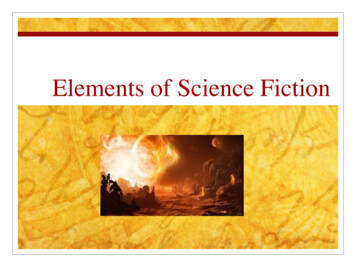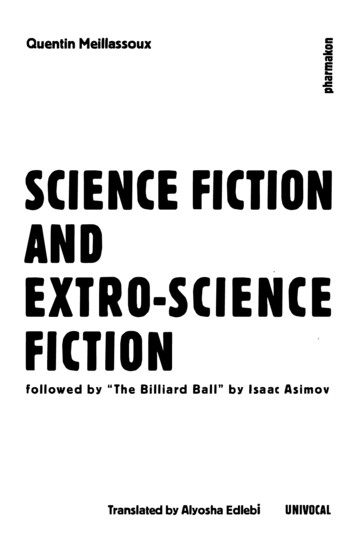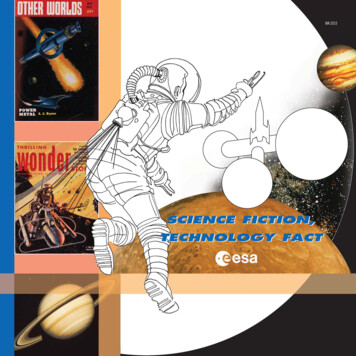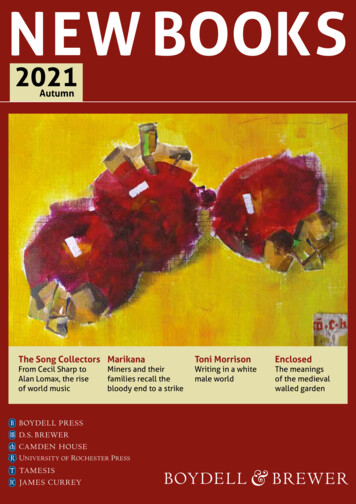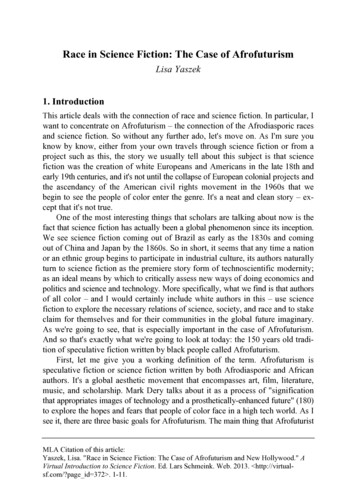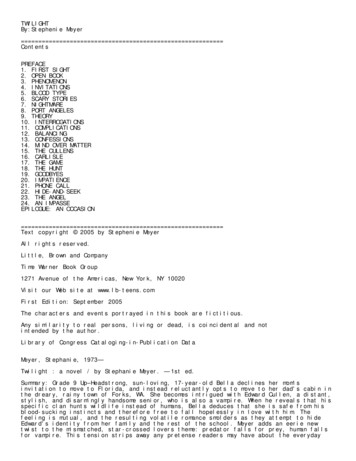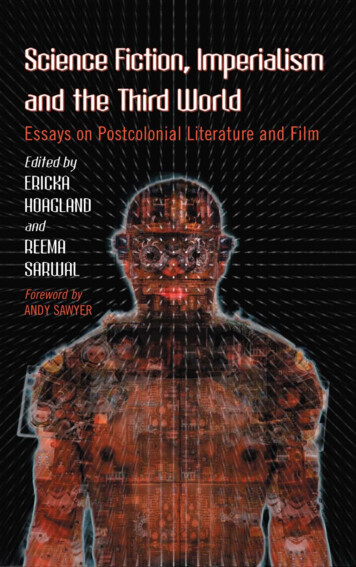
Transcription
Science Fiction, Imperialismand the Third World
This page intentionally left blank
Science Fiction,Imperialismand the Third WorldEssays on PostcolonialLiterature and FilmEDITEDERICKA HOAGLANDREEMA SARWALBYANDForeword by Andy SawyerMcFarland & Company, Inc., PublishersJefferson, North Carolina, and London
LIBRARYOFCONGRESS CATALOGUING-IN-PUBLICATION DATAScience fiction, imperialism and the third world : essays onpostcolonial literature and film / edited by Ericka Hoagland andReema Sarwal ; foreword by Andy Sawyer.p.cm.Includes bibliographical references and index.ISBN 978-0-7864-4789-3softcover : 50# alkaline paper¡. Science fiction, American — History and criticism.2. Science fiction, Indic (English)— History and criticism.3. Science fiction, Mexican — History and criticism. 4. Sciencefiction films — History and criticism. 5. Imperialism in literature.6. Postcolonialism in literature. 7. Literature and globalization.8. Utopias in literature. 9. Dystopias in literature.I. Hoagland, Ericka, ¡975– II. Sarwal, Reema.PS374.S35S335 20¡0809.3' 8762 — dc222010023305British Library cataloguing data are available 20¡0 Ericka Hoagland and Reema Sarwal. All rights reservedNo part of this book may be reproduced or transmitted in any formor by any means, electronic or mechanical, including photocopyingor recording, or by any information storage and retrieval system,without permission in writing from the publisher.Cover image 20¡0 Brand X PicturesManufactured in the United States of AmericaMcFarland & Company, Inc., PublishersBox 6¡¡, Je›erson, North Carolina 28640www.mcfarlandpub.com
AcknowledgmentsWe would first like to thank all our contributors, not only for their articles, but also for their patience and co-operation.Thanks also to Stephen F. Austin State University for the research minigrant to Ericka Hoagland in the early stages of the project.Whole-hearted thanks to Prof. Andy Sawyer for his enthusiastic responseto the manuscript and for writing the Foreword.Personally, a big thank you to Amit Sarwal for all his help and unconditional support.Some of the essays in the collection have been published previously. Theyhave been re-edited and revised here to make them more up-to-date and relevant. Permission given by the following copyright holders (authors, editors,and publishers) is gratefully acknowledged.Gerald Gaylard, “Postcolonialism and the Transhistorical in Dune,” Foundation104 (Summer 2009): 84–101.Diana Pharaoh Francis, “The Colonial Feminine in Pat Murphy’s ‘His VegetableWife,’” Phoebe: Journal of Gender and Cultural Critiques 17.2 (2005): 35–43.Shital Pravinchandra, “The Third-World Body Commodified: Manjula Padmanabhan’s Harvest,” Un/Worldly Bodies, Special. issue of eSharp 8 (Autumn2006): http://www.gla.ac.uk/esharp.Debjani Sengupta, “Sadhanbabu’s Friends: Science Fiction in Bengal from 1882to 1974,” Shaping Technologies, Spl. issue of Sarai Reader 03 (2003): 76–82.Herbert Klein, “Loonies and Others in Robert Heinlein’s The Moon Is a HarshMistress,” Revista Litteralis 3 (2004): 39–60. Permission granted by EdiUri,Santo Angelo, Brazil.Dominic Alessio and Jessica Langer, “Hindu Nationalism and Postcolonialism inIndian Science Fiction: Koi. Mil Gaya (2003)” New Cinemas: Journal of Contemporary Film 5.3 (2007): 217–229 (Intellect Books).v
This page intentionally left blank
Table of ContentsAcknowledgmentsvForewordAndy Sawyer1Introduction: Imperialism, the Third World, and PostcolonialScience FictionEricka Hoagland and Reema Sarwal5Part One: Re-inventing/Alternate History1. Postcolonial Science Fiction: The Desert PlanetGerald Gaylard212. History Deconstructed: Alternative Worlds in StevenBarnes’s Lion’s Blood and Zulu HeartJuan F. Elices373. The Calcutta Chromosome: A Novel of Silence, Slippageand SubversionSuparno Banerjee504. Organization and the Continuum: History in VandanaSingh’s “Delhi”Grant Hamilton65Part Two: Forms of Protest5. The Colonial Feminine in Pat Murphy’s “His VegetableWife”Diana Pharaoh Francis776. Body Markets: The Technologies of Global Capitalismand Manjula Padmanabhan’s HarvestShital Pravinchandra87vii
viiiTable of Contents7. “Smudged, Distorted and Hidden”: Apocalypse asProtest in Indigenous Speculative FictionRoslyn Weaver99Part Three: Fresh Representations8. Sadhanbabu’s Friends: Science Fiction in Bengal from1882 to 1974Debjani Sengupta1159. Critiquing Economic and Environmental Colonization:Globalization and Science Fiction in The Moons ofPalmaresJudith Leggatt12710. Loonies and Others in Robert A. Heinlein’s The MoonIs a Harsh MistressHerbert G. Klein14111. Science Fiction, Hindu Nationalism and Modernity:Bollywood’s Koi. Mil GayaDominic Alessio and Jessica Langer156Part Four: Utopia/Dystopia12. The Shapes of Dystopia: Boundaries, Hybridity andthe Politics of PowerJessica Langer17113. Narrative and Dystopian Forms of Life in MexicanCyberpunk Novel La Primera Calle de la SoledadJuan Ignacio Muñoz Zapata18814. Octavia Butler’s Parable of the Sower : The ThirdWorld as Topos for a U.S. UtopiaGavin Miller202About the Contributors213Index217
ForewordANDY SAWYER“Sf,” writes Uppinder Mehan in an essay on Indian science fiction published in Foundation in 1998, “is as Western as Coca-Cola, big cars and computers” (54). He then, however, points out that science fiction in several ofthe languages of the Indian sub-continent has been published since the earlyyears of the twentieth century. Some years later, Mehan, with CanadianCaribbean writer Nalo Hopkinson, edited So Long Been Dreaming, an anthology of explicitly “postcolonial” science fiction and fantasy. In her introduction(as at least one essay in this book reminds us) Hopkinson noted that whileheading off into the galaxy to colonize new worlds is often a theme of sciencefiction “for many of us that’s not a thrilling adventure story; it’s non fiction”(7). However (as again we are reminded), the tools of sf, its speculative driveand its ability to subvert language and situation, are among the most powerfulweapons available to those who want to “[make] it possible to think aboutnew ways of doing things” (9).Far too many arguments about what sf is and does center upon describingan origin for the form in sources such as Shelley’s Frankenstein, Wells’s “scientific romances,” More’s Utopia or simply the identification in Hugo Gernsback’s first issue of Amazing Stories in April 1926 of the “Jules Verne, H.G.Wells and Edgar Allan Poe type of story — a charming romance intermingledwith scientific fact and prophetic vision” as scientifiction (3). A more creativeapproach, perhaps, is to consider whether all cultures, at all times, have reactedto the idea that change is fueled by both actual science and technology andthe very speculation that sciences and technologies do change the world. Suchan approach, perhaps, allows more voices to be heard and a more open (andcritical) examination of the nature of such change, and of what we mean bysuch slippery concepts as “change,” “difference,” and “otherness.”An explicitly postcolonial science fiction not only has to be written from1
2Foreword (Sawyer)outside the traditional strands of Western science fiction (claiming them asprogenitors, perhaps, while recognizing that the future nowadays is a verydifferent world to that which it once was) but explained and criticized fromoutside them too. Writers such as Octavia Butler, Nalo Hopkinson, or Vandana Singh; and anthologies such as Sheree Thomas’s Dark Matter (2000),Andrea Bell’s Cosmos Latinos (2003) or the aforementioned So Long BeenDreaming have brought new and exciting fictions to sf. Equally, however, therecent issues of Science Fiction Studies on Afrofuturism ( July 2007), or LatinAmerican sf (Nov 2007), and books such as Marlene Barr’s Afro-FutureFemales and John Rieder’s Colonialism and the Emergence of Science Fiction(both 2008) present new and fruitful approaches to how writers and criticsmake it possible to utilize the toolkit given to us by sf in this process of thinking about new ways of doing things. This collection continues the debate. Byexamining such examples as sf in Bengal, Mexican cyberpunk, the portrayalof the Native American in science fiction, sf written by Indigenous Australiansand texts such as the Arthur C. Clarke Award–winning The Calcutta Chromosome, as well as the undercurrents of colonialism and Empire in such traditional examples of twentieth-century sf as Robert A. Heinlein’s The MoonIs a Harsh Mistress or Frank Herbert’s “Dune” sequence, this book adds tothe conversation. It explores the nature of sf ’s critical stance as well as itssometimes uncritical acceptance. It emphasizes, as the editors stress in theintroduction, the fact that both “postcolonial literature” and “science fiction”are in fact processes characterized by contradictions and qualifications; dynamics rather than “things.” As such, and as approaches which focus upon changeand difference, they have much in common, especially their resistance to easydefinition.A postcolonial science fiction allows space for the different “voices” of science fiction in Europe, Latin America and the Asian and African Disaporas,and explores the nature of Otherness and Futurity, and what happens whenthese ideas are expressed by those who were the subjects of earlier versions.It arises from the sense, articulated by Farah Mendlesohn in the introduction to Foundation 100: The Antholog y, that the default future of whatJohn Clute calls the “First SF” of the Hugo Gernsback/John W. Campbellmodel is neither possible nor desirable from where we stand now. (Mendlesohngoes on to note that the futures of the science fiction which echoes the modelof the sf many of us grew up with are “so clearly not the futures of the placesthat so many of us live in” [3].) It asks what happens now that Gernsbackian“First SF” is, if not dead, a very different animal from what readers of theearly American pulp magazines were encouraged to grow up to create, or whathappened to that future which H. G. Wells, whose scientific romances firmly
Foreword (Sawyer)3engaged with exposing the anxieties of Empire, proclaimed would be broughtabout by “the honest application of the Obvious” (322). Neither the wonderfulinventions of a Ralph 124C41 , nor a Wellsian “Modern Utopia” offers solutions we are comfortable with today. We may justifiably ask Wells: what is“honest”? What is “the Obvious”?Similarly, the conquest of space hymned in the 1950s and 60s by ArthurC. Clarke (much of whose fiction betrays the anxiety aroused by that significant word “conquest”), or the cyberfuture hailed (and partly created) by theyoung readers of Neuromancer in the 1980s, or the post-human future of theSingularity which appears so much in contemporary sf, are all features whichdemand the critical treatment William Gibson himself gave “First SF” in hisshort story “The Gernsback Continuum” (1981).A postcolonial sf criticism will also consider whether traditional conceptsof genre are even worth holding on to in the light of the revisioning of theseideas from writers whose connections with the traditional generic historiesand structures of science fiction are second- or third-hand. This collection,reminds us that science fiction, like the world, is not owned by those whonamed and claimed it. I welcome the opportunity to learn from it.Works CitedGernsback, Hugo. “A New Sort of Magazine.” Amazing Stories: The Magazine of Scientifiction 1.1 (April 1926): 3.Hopkinson, Nalo, and Uppinder Mehan. So Long Been Dreaming. Vancouver, BC: ArsenalPulp Press, 2004.Mehan, Uppinder. “The Domestication of Technology in Indian Science Fiction ShortStories.” Foundation 74 (Autumn 1998): 54–66.Mendelsohn, Farah. “Introduction.” Foundation: The International Review of Science Fiction3.4 (2007): 3.Wells, H.G. The Shape of Things to Come. London: Hutchinson, 1935.Andy Sawyer is the Science Fiction Foundation Collection Librarian at the University ofLiverpool. He is a reviewer and contributor to reference books in the sf/fantasy field andhas been a judge for the Arthur C. Clarke Award.
This page intentionally left blank
IntroductionImperialism, the Third World,and Postcolonial Science FictionERICKA HOAGLAND ANDREEMA SARWALAs some would have it, genre — any genre — even one that has existedon the outskirts of “Literature” for most of its existence like science fiction,is a fixed category, and some critics have spent entire careers defending theborders of various genres from definitional onslaughts that would render thegenre too broad, and thus meaningless. Other critics have fought another battle: preventing the borders from closing in, and the genre collapsing in onitself, starved for new voices, new meanings. As many who study sciencefiction know, the “definition war” within the genre is ongoing, as attempts toboth purify the genre and blast its cargo doors open occur alongside eachother. On the other hand, postcolonial literature is not a generic category inthe same sense as science fiction or even fantasy. It does not have any standardsettings (spaceships, imagined planets, pseudo-medieval fantasy lands), motifs(time-travel, quests, war) and characters (scientists, aliens, knights, dragons,wizards) of science fiction and fantasy. The mode of postcolonial literaturemay vary from the realist to the magic realist and everything in between. Infact, postcolonialism is a theoretical lens through which any literature maybe read — from the epics, the Bible and Shakespeare through to spy thrillers,westerns and pulp romance.This introduction, then, seeks to establish a middle ground throughwhich to articulate some thoughts regarding the emerging genre of postcolonial science fiction, a hybrid genre that reflects intriguing affinities betweentwo genres whose own parameters continue to be vigorously contested. Indeed,postcolonial literature and science fiction share much in common: both have5
6Introductionbeen perceived at some point in their histories as literary outcasts; both haveborrowed liberally from other genres, and in so doing have refashioned thosegenres in their image; both have been used in explicitly political ways; bothhave attempted to make sense of a world that is startling in its complexityand brutality; and both have undergone serious, and sometimes damagingassaults questioning the integrity of the genres themselves, how they are used,and by whom. Both genres are inherently moralistic and ethics-driven; eachgenre may force upon its readers difficult questions regarding complicity, loyalty, responsibility, and obligation. Despite these many similarities, how eachgenre is perceived in popular culture reveals a striking difference: sciencefiction has for some time been the repository of special effects-laden blockbusters, iconic television shows, and sweeping sagas tailor-made for miniseries.By comparison, postcolonial literature is a stranger to popular culture, specifically, Western popular culture. If science fiction is plebian, then postcolonialliterature is patrician, an elitist literary genre, and by extension, postcolonialcinema is the province of the independent art house, not the suburbanmegaplex. While this is certainly an exaggeration, it is clear that even in thecurrent political and cultural climate, postcolonial literature is, for lack of abetter word, foreign to many Western readers. Yet the blending of one “familiar” genre with a “foreign” one represents rich creative and critical possibilities,as the pieces collected in this volume show. One of these possibilities, as thetitle of this collection indicates, is a closer examination of the relationshipbetween science fiction and the Third World. Science fiction has long beenviewed as a genre “produced and consumed by young white males” (Roberts29), and as such has been “regularly condemned as the quintessentially masculine genre . filled with muscle-bound macho heroes swaggering and bullying their way through the galaxy” (Westphal qtd. in Roberts 29). Hardly agenre where one would expect to find a sensitive, thoughtful portrayal of difference, or a critical exploration of how the Third World is imagined and represented. And yet, as Adam Roberts points out, the genre “has always hadsympathies with the marginal and the different” (29). It is no surprise, then,that the genre has found a natural home amongst Third World writers, whoare using the genre to reimagine themselves and their world, to “set the recordstraight” by dismantling the stereotypes that science fiction in part has helpedto support, and in essence “strike back” at the empire. Thus this study offersa new way to think about what the “Third World”— both the ideological construct and the geographical space/s represented by the term — means by presenting diverse pieces that reflect the complex nature of the conversation aboutthe Third World as presented in the pages of science fiction. The introductionpresented here is intended to provide both a grounding of the terms central
Introduction (Hoagland and Sarwal)7to this study, namely “postcolonial,” “science fiction,” and “third world,” aswell to explore the overlaps between science fiction and postcolonial literaturein order to articulate a working theory of postcolonial science fiction.First, it is worthwhile to consider science fiction’s relationship to imperialism, a relationship that has never been simple. While on the one hand science fiction “either ignore[s] the problems that exist between different humancultural groups or perpetuates the prejudices of the dominant culture,” presenting alien races in such a way as to assuage imperialist guilt or affirm imperialist desire, on the other hand science fiction has long been critical of thefar-reaching arm of empire (Leggatt 109). Within one of the most famous sffranchises, Star Trek, one can perceive a third strain, what can be termed“ambivalent imperialism” etched within the genre through the prime directive,the highest principle by which the Federation of Planets, and its militaristicscientific arm, Starfleet, operates. The directive enjoins its representatives torefrain from intervening with the natural evolution of a species, even if thatintervention could save that species from annihilation. Acting like an intergalactic disclaimer, the directive is less about protecting the aliens Starfleetencounters than it is about protecting Federation interests and its reputation,a reputation perceived in idealistic ways — cooperative, tolerant, humane,noble — in a future likewise presented idealistically, where humanity has overcome the problems and prejudices Leggat alludes to above. In this sense theprime directive serves as a counternarrative to the violent imperialist encounters of the past, but is no less marked by imperialist desire than the Africanland grab of the nineteenth century. Imperialist desire in the prime directiveis coded through terms like “aid” and “protect,” the larger goal being to encourage planets to willingly join the Federation, and thus be drawn into the empireby choice, rather than force. Furthermore, by imposing strict guidelines asto how Starfleet technology may be shared, Federation superiority is maintained. Episodes exploring the tension between the principle of the directiveand the reality of interstellar relations abound in the franchise, and one ofthe most successful Star Trek films, First Contact, draws heavily from this tension. In one particular episode of Star Trek: The Next Generation, for example,a technologically inferior planet in danger of destruction from violent volcanicactivity is saved through the Enterprise’s intervention, and the only alien, achild, that knows of the Enterprise is returned to her appropriate “state” ofignorance when her memories of the ship and Commander Data are removed.The status quo the directive reflects is preserved, and the Enterprise can revelin its role of intergalactic protector without any residual guilt for interferingwith natural processes because the aliens do not know. In that regard, then,the prime directive operates like any purportedly benign imperialist principle:
8Introductionexpressed in the language of disinterest (we do/do not do this for you, notfor us), rather than desire (we do/do not do this for our gain, whatever thecost to you), such principles, whether they are called prime directives or theWhite Man’s Burden, have infamously supported imperialist practice in boththe real world and the world of science fiction.“In a sense,” Adam Roberts writes, science fiction serves as the “darksubconscious to the thinking mind of Imperialism” (66). That “dark subconscious” is present even when a science fiction text refrains from “questioning,critiquing, or moving beyond the colonizing impulse” (Grewell 26). Indeed,Patricia Kerslake argues that “empire” is integral to any discussion of the genreitself, a viewpoint this collection shares. “As a positive tool for social awareness,” the theme of empire allows science fiction to “seek out and identify[the] most problematic issues” that attend the actual practices of empire (191).The days of empire are not over, which is readily acknowledged within sciencefiction and postcolonial studies (and beyond). This fact of course troubles thevery idea of “postcolonial” literature, theory, and studies, and while it is notthe purpose of this introduction to offer a detailed discussion of the controversysurrounding the actual term “postcolonial,” it is useful to highlight some ofthe central observations of that debate. First, “postcolonial” is a deceptivelyneutral term, suggesting an apolitical nature to the discipline and assumingthat colonialism has come to an end. As such, more appropriate terms, particularly “neocolonialism,” which recognize colonialism’s continued presence,albeit in different forms, have been proffered as a replacement for “postcolonial.” Second, “postcolonial” implies that the “post” can be firmly situated ata specific date; that is, just as the term appears to be politically neutral, sotoo does it present itself as temporally general, and this occludes the fact thatcolonies did not become “post” at the same time. Likewise, any broad categorical marker tends to favor the generally applicable, and as such, the specificdifferences between India’s experience as the jewel in Britain’s imperial crownand the Caribbean’s history of displacement and slavery can be easily subordinated to basic similarities. Ania Loomba points out that the term “is notonly inadequate to the task of defining contemporary realities in [.] oncecolonised countries, and vague in terms of indicating a specific period of history, but may also cloud the internal social and racial differences of manysocieties” (8). Indeed, the experience of colonialism within a society can varyat least according to gender and class. At best, the term should be consideredas loosely binding, acknowledging similarity, but not ignoring the “contradictions and qualifications” which “riddle” the term (Loomba 12). In this collection, then, “postcolonial,” is understood more “flexibly as the contestationof colonial domination and the legacies of colonialism” (Loomba 12). As
Introduction (Hoagland and Sarwal)9Robert J.C. Young notes, “postcolonialism seeks to intervene, to force itsalternative knowledges into the power structures of the west as well as thenon-west. It seeks to change the way people think, the way they behave, toproduce a more just and equitable relation between the different peoples ofthe world” (7).Like “postcolonial,” science fiction “resists easy definition,” and thus,numerous definitions of the term abound (Roberts 1). This leads Paul K.Alkon to note that “the polysemy of the term science fiction, reflected in theinability of critics to arrive at agreement on any one definition, is a measureof science fiction’s complex significance for our times” (9). A literature of theimagination, yet often grounded in the logic of science; an ethical enterprisepackaged as entertainment; and a forward looking project that is frequentlyrooted in anxieties about the present (as well as the past): science fiction is agenre that feeds off of conflicting impulses — of exploration and xenophobia,conquest and exchange, and technophilia and technophobia, to name a few.Rather than attempt to summarize the genre’s many definitions, which rangefrom the incredibly specific to the laughably broad, four particular aspects ofthe genre will be considered, all in relation to one of sf ’s most dominant definitional markers, imperialism. These are the genre’s relationship to history;the centrality of the other in the majority of sf narratives; what Greg Grewell,borrowing from Fredric Jameson, calls the “master narratives” of sf film — theexplorative, the domesticative, and the combative (28); and “the contemplation of the human condition,” or in other words, the genre’s emphasis onsocial and ethical issues (Alkon 5). Taken together, these elements serve as aframework for articulating a definition of postcolonial science fiction.Science fiction is often perceived as being prophetic, but as Roberts notes,“the truth is that most SF texts are more interested in the way things havebeen” (33). At best, he argues, science fiction has a “surface attachment to ‘thefuture’”; instead, the genre is driven by nostalgia (Roberts cites several examples, including Dune’s Arabic Middle Ages socio-political setting). In essence,the nostalgic drive of sf can be understood as the future made familiar. Thus,the future is relegated to mere stage dressing, as the past is obsessively revisitedand reconsidered. This is particularly evident in the pages of alternative histories, like Philip K. Dick’s The Man in the High Castle or Harry Turtledove’sWorldwar series, in which the possibilities of the “what if ” are vigorously pursued. By exploring an alternative timeline, such “histories” actually “make[their] readers feel better about their own timeline, however troubled it maybe” (Duncan 216). In this way, then, nostalgia for the now, as well as for thepast that created that now, is encouraged. Star Trek hurtles that nostalgia forthe now into an imagined, yet familiar future; in this instance, one strikingly
10IntroductionAmerican in its celebration of galactic democracy and equality. As texts likeWar of the Worlds and The Martian Chronicles show, however, sf does not viewthe past, or the present, only through the lens of nostalgia. These three texts —Star Trek, War of the Worlds, and The Martian Chronicles —highlight sciencefiction’s supposedly divided relationship with / to history. On the one hand,history is a record of the inevitable, both good and bad, and is itselfimmutable; on the other, history is perceived both more critically and fluidly.Yet both positions lead to the same end: a revaluation of the past, where ithas brought us, and where it might take us. The history of imperialism, as itis presented in both science fiction and postcolonial texts, reflects that dynamictension between inevitability and stasis, and productive change. Authors likeWells and Bradbury reject imperialism’s inevitability and instead highlightthe damage — physical, psychological, and ethical — of a project that is stillviewed by some nostalgically. Science fiction texts that draw such explicit andcritical attention to how imperialist history is constructed and maintained isin part how postcolonial science fiction may be defined. Embedded in Eurocentric values and frames of reference, the historical record is seen as suspect,in desperate need of, at the very least, revising, if not outright rejection. Therewriting/revising of history and the recovery of the subaltern subject, integralcomponents to postcolonial studies, are mirrors of science fiction’s complexrelationship with history and the haunting presence of aliens and others likeBradbury’s Martians.The “Other” is one of the most well-known markers that science fictionand postcolonial literature share in common. As Adam Roberts has noted,“.the key symbolic function of the SF novum is precisely the representationof the encounter with difference, Otherness, alterity” (25). In postcolonialstudies, the “Other” is not only situated as the aberrant of the imperialistnorm (a norm that is the same as that which marks difference in sf ), but significantly by the denial of the “individuation” that is the right of the normonly (Loomba 52). The function of the “Other” is intriguingly similar in bothgenres: the “Other” consolidates difference as well as solidifies the norm; asboth a theoretical concept and a tangible object, the “Other” is used to justifythe exploitation and annihilation of peoples, whether red, black, or green; itis used to explain how repulsion and desire can exist concurrently; and it signifies an ever-looming threat of contamination (by sex or disease) as well asviolence. Perhaps the most significant function the “Other” serves in bothgenres is that “.encountering the Other forces us to encounter ourselves,”Roberts writes, and “the way it can reveal things about ourselves which areintensely uncomfortable” (27). It is for this reason that Damien Broderick“wonders if SF does ‘above all else, write the narrative of the other/s?,’” but
Introduction (Hoagland and Sarwal)11Broderick “goes on to say that even if we take that ‘in the spirit of description(though hardly of definition)’ we still have to accept that ‘SF writes, rather,the definition of the same, as other’” (Broderick 1995: 51 qtd. in Roberts 28).The same/other relationship is similarly complex in postcolonial literature,where identification of the norm with the other can lead to disgust, just asidentification with the same can create intense feelings of betrayal and selfhatred in those marked “Other.” Bradbury’s sympathetic portrayal of theother, the doomed Martians in The Martian Chronicles is a solid example ofhow science fiction is frequently used as a space to challenge longstandingattitudes. “In other words,” Roberts writes, “in
Foundation: The International Review of Science Fiction 3.4 (2007): 3. Wells, H.G. The Shape of Things to Come. London: Hutchinson, 935.1 Foreword (Sawyer) 3 Andy Sawyer is the Science Fiction Foundation Collection Librarian at the University of Liverpool. He is a reviewer and contributor to re


